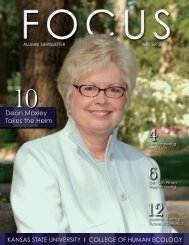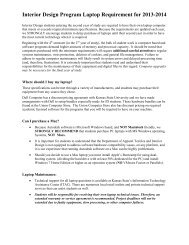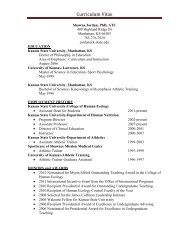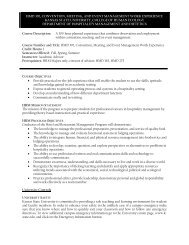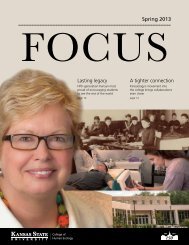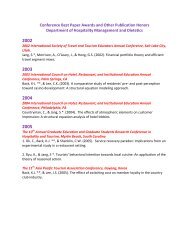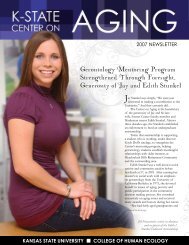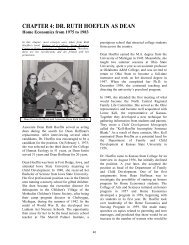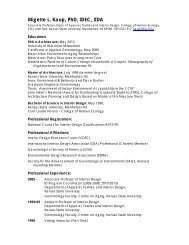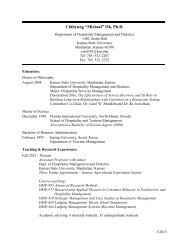Global Health and Aging - World Health Organization
Global Health and Aging - World Health Organization
Global Health and Aging - World Health Organization
- No tags were found...
You also want an ePaper? Increase the reach of your titles
YUMPU automatically turns print PDFs into web optimized ePapers that Google loves.
<strong>Global</strong> <strong>Health</strong> <strong>and</strong> <strong>Aging</strong>National Institute on <strong>Aging</strong>National Institutes of <strong>Health</strong>U.S. Department of <strong>Health</strong> <strong>and</strong> Human Services
4 <strong>Global</strong> <strong>Health</strong> <strong>and</strong> <strong>Aging</strong>
PrefaceThe world is facing a situation without precedent: We soon will have more older people thanchildren <strong>and</strong> more people at extreme old age than ever before. As both the proportion of olderpeople <strong>and</strong> the length of life increase throughout the world, key questions arise. Will populationaging be accompanied by a longer period of good health, a sustained sense of well-being, <strong>and</strong>extended periods of social engagement <strong>and</strong> productivity, or will it be associated with more illness,disability, <strong>and</strong> dependency? How will aging affect health care <strong>and</strong> social costs? Are these futuresinevitable, or can we act to establish a physical <strong>and</strong> social infrastructure that might foster betterhealth <strong>and</strong> wellbeing in older age? How will population aging play out differently for low-incomecountries that will age faster than their counterparts have, but before they become industrialized<strong>and</strong> wealthy?This brief report attempts to address some of these questions. Above all, it emphasizes the centralrole that health will play moving forward. A better underst<strong>and</strong>ing of the changing relationshipbetween health with age is crucial if we are to create a future that takes full advantage of thepowerful resource inherent in older populations. To do so, nations must develop appropriatedata systems <strong>and</strong> research capacity to monitor <strong>and</strong> underst<strong>and</strong> these patterns <strong>and</strong> relationships, well-being. And research needs to be better coordinated if we are to discover the most cost-effectiveways to maintain healthful life styles <strong>and</strong> everyday functioning in countries at different stages ofeconomic development <strong>and</strong> with varying resources. <strong>Global</strong> efforts are required to underst<strong>and</strong> <strong>and</strong>existing knowledge about the prevention <strong>and</strong> treatment of heart disease, stroke, diabetes, <strong>and</strong>cancer.Managing population aging also requires building needed infrastructure <strong>and</strong> institutions as soon aspossible. The longer we delay, the more costly <strong>and</strong> less effective the solutions are likely to be.Population aging is a powerful <strong>and</strong> transforming demographic force. We are only just beginningto comprehend its impacts at the national <strong>and</strong> global levels. As we prepare for a new demographicreality, we hope this report raises awareness not only about the critical link between global health<strong>and</strong> aging, but also about the importance of rigorous <strong>and</strong> coordinated research to close gaps in ourknowledge <strong>and</strong> the need for action based on evidence-based policies.Richard Suzman, PhDDirector, Division of Behavioral <strong>and</strong> Social ResearchNational Institute on <strong>Aging</strong>National Institutes of <strong>Health</strong>John Beard, MBBS, PhDDirector, Department of Ageing <strong>and</strong> Life Course<strong>World</strong> <strong>Health</strong> <strong>Organization</strong>Preface15
security of older people, <strong>and</strong> that provide thehealth <strong>and</strong> social care they need, without thesame extended period of economic growthexperienced by aging societies in the West.In other words, some countries may grow oldbefore they grow rich.Crystal Craig | Dreamstime.comIn some countries, the sheer number ofpeople entering older ages will challengenational infrastructures, particularly healthsystems. This numeric surge in older people ispopulous countries: China <strong>and</strong> India (Figure 3).will likely swell to 330 million by 2050 from 110of 60 million is projected to exceed 227 millionin 2050, an increase of nearly 280 percent fromtoday. By the middle of this century, therecould be 100 million Chinese over the age of 80.This is an amazing achievement consideringthat there were fewer than 14 million peoplethis age on the entire planet just a century ago.Figure 3.Growth of the Population Aged 65 <strong>and</strong> Older in India <strong>and</strong> China:2010-2050Source: United Nations. <strong>World</strong> Population Prospects: The 2010 Revision.Available at: http://esa.un.org/unpd/wpp.Humanity’s <strong>Aging</strong>5
Living LongerThe dramatic increase in average life expectancyduring the 20th century ranks as one ofbabies born in 1900 did not live past age 50, lifeexpectancy at birth now exceeds 83 years inJapan—the current leader—<strong>and</strong> is at least 81years in several other countries. Less developedregions of the world have experienced a steadyincrease in life expectancy since <strong>World</strong> WarII, although not all regions have shared inthese improvements. (One notable exceptionis the fall in life expectancy in many parts ofAfrica because of deaths caused by the HIV/AIDS epidemic.) The most dramatic <strong>and</strong> rapidgains have occurred in East Asia, where lifeexpectancy at birth increased from less than 45years in 1950 to more than 74 years today.These improvements are part of a majortransition in human health spreading aroundthe globe at different rates <strong>and</strong> along differentBerna Namoglu | Dreamstime.compathways. This transition encompasses abroad set of changes that include a declinefrom high to low fertility; a steady increasein life expectancy at birth <strong>and</strong> at older ages;<strong>and</strong> a shift in the leading causes of death <strong>and</strong>illness from infectious <strong>and</strong> parasitic diseasesto noncommunicable diseases <strong>and</strong> chronicconditions. In early nonindustrial societies, therisk of death was high at every age, <strong>and</strong> only asmall proportion of people reached old age. Inmodern societies, most people live past middleage, <strong>and</strong> deaths are highly concentrated at olderages.The victories against infectious <strong>and</strong> parasiticdiseases are a triumph for public healthprojects of the 20th century, which immunizedmillions of people against smallpox, polio,<strong>and</strong> major childhood killers like measles. Evenearlier, better living st<strong>and</strong>ards, especiallymore nutritious diets <strong>and</strong> cleaner drinkingwater, began to reduce serious infections <strong>and</strong>prevent deaths among children. More childrenwere surviving their vulnerable early years<strong>and</strong> reaching adulthood. In fact, more than60 percent of the improvement in female lifeexpectancy at birth in developed countriesbetween 1850 <strong>and</strong> 1900 occurred because morechildren were living to age 15, not because morethe 20th century that mortality rates beganto decline within the older ages. Research formore recent periods shows a surprising <strong>and</strong>continuing improvement in life expectancyamong those aged 80 or above.The progressive increase in survival in theseoldest age groups was not anticipated bydemographers, <strong>and</strong> it raises questions about howhigh the average life expectancy can realisticallyrise <strong>and</strong> about the potential length of the humanlifespan. While some experts assume that lifeexpectancy must be approaching an upper limit,6 <strong>Global</strong> <strong>Health</strong> <strong>and</strong> <strong>Aging</strong>
Figure 4.Female Life Expectancy in Developed Countries: 1840-2009Source: Highest reported life expectancy for the years 1840 to 2000 from online supplementarymaterial to Oeppen J, Vaupel JW. Broken limits to life expectancy. Science 2002; 296:1029-1031. All other data points from the Human Mortality Database (http://www.mortality.org)provided by Rol<strong>and</strong> Rau (University of Rostock). Additional discussion can be found inChristensen K, Doblhammer G, Rau R, Vaupel JW. <strong>Aging</strong> populations: The challenges ahead.The Lancet 2009; 374/9696:1196-1208.Living Longer7
data on life expectancies between 1840 <strong>and</strong> 2007show a steady increase averaging about threemonths of life per year. The country with thehighest average life expectancy has varied overtime (Figure 4). In 1840 it was Sweden <strong>and</strong>today it is Japan—but the pattern is strikinglysimilar. So far there is little evidence that lifeexpectancy has stopped rising even in Japan.The rising life expectancy within the olderpopulation itself is increasing the number <strong>and</strong>proportion of people at very old ages. The“oldest old” (people aged 85 or older) constitute 12 percent in more developed countries <strong>and</strong> 6percent in less developed countries. In manycountries, the oldest old are now the fastestgrowing part of the total population. On aglobal level, the 85-<strong>and</strong>-over population isprojected to increase 351 percent between 2010<strong>and</strong> 2050, compared to a 188 percent increase forthe population aged 65 or older <strong>and</strong> a 22 percentincrease for the population under age 65 (Figure 5).The global number of centenarians is projectedto increase 10-fold between 2010 <strong>and</strong> 2050. Inthe mid-1990s, some researchers estimated that,over the course of human history, the odds ofliving from birth to age 100 may have risen from1 in 20,000,000 to 1 in 50 for females in lowmortalitynations such as Japan <strong>and</strong> Sweden.than current projections assume—previouspopulation projections often underestimateddecreases in mortality rates among the oldestold.Figure 5.Percentage Change in the <strong>World</strong>’s Population by Age: 2010-2050Source: United Nations, <strong>World</strong> Population Prospects: The 2010 Revision.Available at: http://esa.un.org/unpd/wpp.8 <strong>Global</strong> <strong>Health</strong> <strong>and</strong> <strong>Aging</strong>
New Disease PatternsThe transition from high to low mortality<strong>and</strong> fertility that accompanied socioeconomicdevelopment has also meant a shift inthe leading causes of disease <strong>and</strong> death.Demographers <strong>and</strong> epidemiologists describe thisshift as part of an “epidemiologic transition”characterized by the waning of infectious <strong>and</strong>acute diseases <strong>and</strong> the emerging importance ofchronic <strong>and</strong> degenerative diseases. High deathrates from infectious diseases are commonlyassociated with the poverty, poor diets, <strong>and</strong>limited infrastructure found in developingcountries. Although many developing countriesstill experience high child mortality frominfectious <strong>and</strong> parasitic diseases, one of themajor epidemiologic trends of the currentcentury is the rise of chronic <strong>and</strong> degenerativediseases in countries throughout the world—regardless of income level.Evidence from the multicountry <strong>Global</strong> Burdenof Disease project <strong>and</strong> other internationalepidemiologic research shows that healthproblems associated with wealthy <strong>and</strong> agedpopulations affect a wide <strong>and</strong> exp<strong>and</strong>ingswath of world population. Over the next10 to 15 years, people in every world regionwill suffer more death <strong>and</strong> disability fromsuch noncommunicable diseases as heartdisease, cancer, <strong>and</strong> diabetes than fromFigure 6.The Increasing Burden of Chronic Noncommunicable Diseases:2008 <strong>and</strong> 2030Source: <strong>World</strong> <strong>Health</strong> <strong>Organization</strong>, Projections of Mortality <strong>and</strong> Burden of Disease, 2004-2030.Available at: http://www.who.int/healthinfo/global_burden_disease/projections/en/index.html.New Disease Patterns9
infectious <strong>and</strong> parasitic diseases. The myththat noncommunicable diseases affect mainlythe project, which combines information aboutmortality <strong>and</strong> morbidity from every world regiondiseases. The burden is measured by estimating the based on detailed epidemiological information. In2008, noncommunicable diseases accounted for anestimated 86 percent of the burden of disease inhigh-income countries, 65 percent in middle-incomecountries, <strong>and</strong> a surprising 37 percent in low-incomecountries.By 2030, noncommunicable diseases are projectedto account for more than one-half of the diseaseburden in low-income countries <strong>and</strong> more thanthree-fourths in middle-income countries.Infectious <strong>and</strong> parasitic diseases will account for30 percent <strong>and</strong> 10 percent, respectively, in low- <strong>and</strong>middle-income countries (Figure 6). Among the60-<strong>and</strong>-over population, noncommunicable diseasesalready account for more than 87 percent of theburden in low-, middle-, <strong>and</strong> high-income countries.But the continuing health threats fromcommunicable diseases for older people cannotbe dismissed, either. Older people account for agrowing share of the infectious disease burden inlow-income countries. Infectious disease programs,including those for HIV/AIDS, often neglectolder people <strong>and</strong> ignore the potential effects ofpopulation aging. Yet, antiretroviral therapy isenabling more people with HIV/AIDS to surviveto older ages. And, there is growing evidencethat older people are particularly susceptibleto infectious diseases for a variety of reasons,including immunosenescence (the progressivedeterioration of immune function with age)<strong>and</strong> frailty. Older people already suffering fromone chronic or infectious disease are especiallyvulnerable to additional infectious diseases. Forexample, type 2 diabetes <strong>and</strong> tuberculosis are wellknown“comorbid risk factors” that have serioushealth consequences for older people.Lasting Importance of Child health problems in adulthood <strong>and</strong> old age stemfrom infections <strong>and</strong> health conditions early in life.Some researchers argue that important aspects ofadult health are determined before birth, <strong>and</strong> thatnourishment in utero <strong>and</strong> during infancy has adirect bearing on the development of risk factors foradult diseases—especially cardiovascular diseases.Early malnutrition in Latin America is highlycorrelated with self-reported diabetes, for example,<strong>and</strong> childhood rheumatic fever is a frequent cause ofadult heart disease in developing countries.Research also shows that delayed physical growth inchildhood reduces physical <strong>and</strong> cognitive functioningrarely or never suffering from serious illnesses orreceiving adequate medical care during childhoodresults in a much lower risk of suffering cognitiveimpairments or physical limitations at ages 80 orolder.Proving links between childhood health conditions<strong>and</strong> adult development <strong>and</strong> health is a complicatedresearch challenge. Researchers rarely have the datanecessary to separate the health effects of changesin living st<strong>and</strong>ards or environmental conditionsto his or her birth or childhood diseases. However,a Swedish study with excellent historical dataconcluded that reduced early exposure to infectiousdiseases was related to increases in life expectancy.A cross-national investigation of data from twosurveys of older populations in Latin America<strong>and</strong> the Caribbean also found links between earlyconditions <strong>and</strong> later disability. The older people inthe studies were born <strong>and</strong> grew up during timesof generally poor nutrition <strong>and</strong> higher risk ofexposure to infectious diseases. In the Puerto Ricansurvey, the probability of being disabled was morethan 64 percent higher for people growing up in10 <strong>Global</strong> <strong>Health</strong> <strong>and</strong> <strong>Aging</strong>
hood <strong>Health</strong>poor conditions than for people growing up in goodconditions. A survey of seven urban centers in LatinAmerica <strong>and</strong> the Caribbean found the probabilityof disability was 43 percent higher for those fromdisadvantaged backgrounds than for those from morefavorable ones (Figure 7).If these links between early life <strong>and</strong> health at olderages can be established more directly, they may havecountries. People now growing old in low- <strong>and</strong> middleincomecountries are likely to have experienced moredistress <strong>and</strong> disadvantage as children than theircounterparts in the developed world, <strong>and</strong> studiessuch as those described above suggest that they areat much greater risk of health problems in older age,often from multiple noncommunicable diseases.Behavior <strong>and</strong> exposure to health risks during aExposure to toxic substances at work or at home,arduous physical work, smoking, alcohol consumption,diet, <strong>and</strong> physical activity may have long-term healthimplications.Figure 7.Probability of Being Disabled among Elderly in Seven Cities of LatinAmerica <strong>and</strong> the Caribbean (2000) <strong>and</strong> Puerto Rico (2002-2003) by Early LifeConditionsSource: Monteverde M, Norohna K, Palloni A. 2009. Effect of early conditions on disability among theelderly in Latin-America <strong>and</strong> the Caribbean. Population Studies 2009;63/1: 21-35.New Disease Patterns11
Longer Lives <strong>and</strong> DisabilityAre we living healthier as well as longer lives, orare our additional years spent in poor health?There is considerable debate about this questionamong researchers, <strong>and</strong> the answers have broadimplications for the growing number of olderpeople around the world. One way to examinethe question is to look at changes in rates ofdisability, one measure of health <strong>and</strong> function.Some researchers think there will be a decreasein the prevalence of disability as life expectancyincreases, termed a “compression of morbidity.”Others see an “expansion of morbidity”—anincrease in the prevalence of disability as lifeexpectancy increases. Yet others argue that, asadvances in medicine slow the progression fromchronic disease to disability, severe disabilitywill lessen, but milder chronic diseases willincrease. In the United States, between 1982<strong>and</strong> 2001 severe disability fell about 25 percentamong those aged 65 or older even as lifeexpectancy increased. This very positive trendsuggests that we can affect not only how longwe live, but also how well we can function withadvancing age. Unfortunately, this trend maynot continue in part because of rising obesityamong those now entering older ages.We have less information about disability inmiddle- <strong>and</strong> lower-income countries. With therapid growth of older populations throughoutthe world—<strong>and</strong> the high costs of managingpeople with disabilities—continuing <strong>and</strong> betterassessment of trends in disability in differentcountries will help researchers discover moreabout why there are such differences acrosscountries.Some new international, longitudinal researchdesigned to compare health across countriespromises to provide new insights, movingforward. A 2006 analysis sponsored by the U.S.National Institute on <strong>Aging</strong> (NIA), part ofthe U.S. National Institutes of <strong>Health</strong>, foundsurprising health differences, for example,between non-Hispanic whites aged 55 to 64in the United States <strong>and</strong> Engl<strong>and</strong>. In general,people in higher socioeconomic levels have betterhealth, but the study found that older adults inthe United States were less healthy than theirBritish counterparts at all socioeconomic levels.The health differences among these “young”older people were much greater than the gapsin life expectancy between the two countries.Because the analysis was limited to non-the generally lower health status of blacks orLatinos. The analysis also found that differencesin education <strong>and</strong> behavioral risk factors (such assmoking, obesity, <strong>and</strong> alcohol use) explained fewof the health differences.This analysis subsequently included comparableNIA-funded surveys in 10 other Europeancountries <strong>and</strong> was exp<strong>and</strong>ed to adults aged 50 toreported worse health than did European adultsas indicated by the presence of chronic diseases<strong>and</strong> by measures of disability (Figure 8). At alllevels of wealth, Americans were less healthythan their European counterparts. Analyses ofthe same data sources also showed that cognitivefunctioning declined further between ages 55 <strong>and</strong>65 in countries where workers left the labor forceat early ages, suggesting that engagement inwork might help preserve cognitive functioning.Subsequent analyses of these <strong>and</strong> other studiesshould shed more light on these nationaldifferences <strong>and</strong> similarities <strong>and</strong> should help guide12 <strong>Global</strong> <strong>Health</strong> <strong>and</strong> <strong>Aging</strong>
Figure 8.Prevalence of Chronic Disease <strong>and</strong> Disability among Men <strong>and</strong>Women Aged 50-74 Years in the United States, Engl<strong>and</strong>, <strong>and</strong> Europe:2004Source: Adapted from Avendano M, Glymour MM, Banks J, Mackenbach JP. <strong>Health</strong> disadvantagein US adults aged 50 to 74 years: A comparison of the health of rich <strong>and</strong> poor Americanswith that of Europeans. American Journal of Public <strong>Health</strong> 2009; 99/3:540-548, using data fromthe <strong>Health</strong> <strong>and</strong> Retirement Study, the English Longitudinal Study of Ageing, <strong>and</strong> the Survey of<strong>Health</strong>, Ageing <strong>and</strong> Retirement in Europe. Please see original source for additional information.Longer Lives <strong>and</strong> Disability13
The Burden of DementiaThe cause of most dementia is unknown, but the memory, reasoning, speech, <strong>and</strong> other cognitivefunctions. The risk of dementia increases sharplywith age <strong>and</strong>, unless new strategies for prevention<strong>and</strong> management are developed, this syndromeis expected to place growing dem<strong>and</strong>s on healthpopulation ages. Dementia prevalence estimatesvary considerably internationally, in partbecause diagnoses <strong>and</strong> reporting systems are notst<strong>and</strong>ardized. The disease is not easy to diagnose,especially in its early stages. The memoryproblems, misunderst<strong>and</strong>ings, <strong>and</strong> behaviorcommon in the early <strong>and</strong> intermediate stagesare often attributed to normal effects of aging,accepted as personality traits, or simply ignored.Many cases remain undiagnosed even in theintermediate, more serious stages. A cross-nationalassessment conducted by the <strong>Organization</strong> forEconomic Cooperation <strong>and</strong> Development (OECD)estimated that dementia affected about 10 millionpeople in OECD member countries around 2000,just under 7 percent of people aged 65 or older.form of dementia <strong>and</strong> accounted for between cited in the OECD report. More recent analyseshave estimated the worldwide number of peopleliving with AD/dementia at between 27 million<strong>and</strong> 36 million. The prevalence of AD <strong>and</strong> otherdementias is very low at younger ages, then nearly 65. In the OECD review, for example, dementiaaffected fewer than 3 percent of those aged 65 to69, but almost 30 percent of those aged 85 to 89.More than one-half of women aged 90 or olderhad dementia in France <strong>and</strong> Germany, as didabout 40 percent in the United States, <strong>and</strong> justunder 30 percent in Spain.The projected costs of caring for the growingnumbers of people with dementia are daunting.Disease International estimates that the totalworldwide cost of dementia exceeded US$600billion in 2010, including informal care providedby family <strong>and</strong> others, social care provided bycommunity care professionals, <strong>and</strong> direct costs ofmedical care. Family members often play a keycaregiving role, especially in the initial stages ofwhat is typically a slow decline. Ten years ago,U.S. researchers estimated that the annual costof informal caregiving for dementia in the UnitedStates was US$18 billion.The complexity of the disease <strong>and</strong> the wide people <strong>and</strong> families dealing with dementia, <strong>and</strong><strong>and</strong> social impact. The challenge is even greaterin the less developed world, where an estimatedtwo-thirds or more of dementia sufferers livebut where few coping resources are available.suggest that 115 million people worldwide willbe living with AD/dementia in 2050, with amarkedly increasing proportion of this total inless developed countries (Figure 9). <strong>Global</strong> effortsways of preventing such age-related diseases asViesturs Kalvans | Dreamstime.com14 <strong>Global</strong> <strong>Health</strong> <strong>and</strong> <strong>Aging</strong>
Figure 9.The Growth of Numbers of People with Dementia in High- incomeCountries <strong>and</strong> Low- <strong>and</strong> Middle-income Countries: 2010-2050Source: Alzheimer’s Disease International, <strong>World</strong> Alzheimer Report, 2010. Available at:Longer Lives <strong>and</strong> Disability15
New Data on <strong>Aging</strong> <strong>and</strong> <strong>Health</strong>The transition from high to low mortality <strong>and</strong>fertility—<strong>and</strong> the shift from communicable tononcommunicable diseases—occurred fairlyrecently in much of the world. Still, accordingto the <strong>World</strong> <strong>Health</strong> <strong>Organization</strong> (WHO), mostcountries have been slow to generate <strong>and</strong> useevidence to develop an effective health responseto new disease patterns <strong>and</strong> aging populations.In light of this, the organization mounted amulticountry longitudinal study designed tosimultaneously generate data, raise awareness ofthe health issues of older people, <strong>and</strong> inform publicpolicies.The WHO Study on <strong>Global</strong> Ageing <strong>and</strong> Adult<strong>Health</strong> (SAGE) involves nationally representativecohorts of respondents aged 50 <strong>and</strong> over in sixcountries (China, Ghana, India, Mexico, Russia,<strong>and</strong> South Africa), who will be followed as they age.A cohort of respondents aged 18 to 49 also will befollowed over time in each country for comparison. has been completed, with future waves planned for2012 <strong>and</strong> 2014.In addition to myriad demographic <strong>and</strong>socioeconomic characteristics, the study collectsdata on risk factors, health exams, <strong>and</strong> biomarkers.Biomarkers such as blood pressure <strong>and</strong> pulse rate,height <strong>and</strong> weight, hip <strong>and</strong> waist circumference,<strong>and</strong> objective measures that improve the precisionof self-reported health in the survey. SAGE alsocollects data on grip strength <strong>and</strong> lung capacityFigure 10.Overall <strong>Health</strong> Status Score in Six Countries for Males <strong>and</strong> Females:Circa 2009Notes: <strong>Health</strong> score ranges from 0 (worst health) to 100 (best health) <strong>and</strong> is a composite measurederived from 16 functioning questions using item response theory. National data collections conductedduring the period 2007-2010.Source: Tabulations provided by the <strong>World</strong> <strong>Health</strong> <strong>Organization</strong> Multi-Country Studies Unit,Geneva, based on data from the Study on global AGEing <strong>and</strong> adult health (SAGE).16 <strong>Global</strong> <strong>Health</strong> <strong>and</strong> <strong>Aging</strong>
<strong>and</strong> administers tests of cognition, vision, <strong>and</strong>mobility to produce objective indicators ofactivities of daily living. As additional waves later years, the study will seek to monitor healthwell-being.A primary objective of SAGE is to obtain reliable<strong>and</strong> valid data that allow for internationalcomparisons. Researchers derive a compositemeasure from responses to 16 questions abouthealth <strong>and</strong> physical limitations. This health scoreranges from 0 (worst health) to 100 (best health)<strong>and</strong> is shown for men <strong>and</strong> women in each of the sixSAGE countries in Figure 10. In each country, thehealth status score declines with age, as expected.And at each age in each country, the score for malesis higher than for females. Women live longer thanmen on average, but have poorer health status.The number of disabled people in most developingcountries seems certain to increase as the numberof older people continues to rise. <strong>Health</strong> systemsneed better data to underst<strong>and</strong> the health risksfaced by older people <strong>and</strong> to target appropriateprevention <strong>and</strong> intervention services. TheSAGE data show that the percentage of peoplewith at least three of six health risk factors(physical inactivity, current tobacco use, heavyalcohol consumption, a high-risk waist-hipratio, hypertension, or obesity) rises withage, but the patterns <strong>and</strong> the percentagesvary by country (Figure 11). important contributions will be to assess<strong>and</strong> future disability. Smaller family size <strong>and</strong>declining prevalence of co-residence by multiplegenerations likely will introduce furtherchallenges for families in developing countries incaring for older relatives.Figure 11.Percentage of Adults with Three or More Major Risk Factors: Circa 200960%50%40%30%20%10%0%18-49 50-59 60-69 70-79 80+Age GroupNotes: Major risk factors include physical inactivity, current tobacco use, heavy alcohol consumption,a high-risk waist-hip ratio, hypertension, <strong>and</strong> obesity. National data collections conductedduring the period 2007-2010.Source: Tabulations provided by the <strong>World</strong> <strong>Health</strong> <strong>Organization</strong> Multi-Country Studies Unit,Geneva, based on data from the Study on global AGEing <strong>and</strong> adult health (SAGE).New Data on <strong>Aging</strong> <strong>and</strong> <strong>Health</strong>17
Assessing the Costs of <strong>Aging</strong><strong>and</strong> <strong>Health</strong> Careof health care spending in both developed <strong>and</strong>developing countries in the decades to come.In developed countries, where acute care <strong>and</strong>institutional long-term care services are widelyavailable, the use of medical care services byadults rises with age, <strong>and</strong> per capita expenditureson health care are relatively high among older agegroups. Accordingly, the rising proportion of olderpeople is placing upward pressure on overall healthcare spending in the developed world, althoughother factors such as income growth <strong>and</strong> advancesin the technological capabilities of medicinegenerally play a much larger role.Relatively little is known about aging <strong>and</strong>health care costs in the developing world. Manydeveloping nations are just now establishingbaseline estimates of the prevalence <strong>and</strong> incidenceof various diseases <strong>and</strong> conditions. from the WHO SAGE project, which provides dataon blood pressure among women in six developingcountries, show an upward trend by age in thepercentage of women with moderate or severehypertension (see Figure 12), although the patterns the countries. If rising hypertension rates inthose populations are not adequately addressed,the resulting high rates of cerebrovascular <strong>and</strong>Figure 12.Percentage of Women with Moderate or Severe Hypertension in SixCountries: Circa 200950%40%30%20%10%0%18-49 50-59 60-69 70-79 80+Age GroupNote: National data collections conducted during the period 2007-2010.Source: Tabulations provided by the <strong>World</strong> <strong>Health</strong> <strong>Organization</strong> Multi-Country Studies Unit,Geneva, based on data from the Study on global AGEing <strong>and</strong> adult health (SAGE).18 <strong>Global</strong> <strong>Health</strong> <strong>and</strong> <strong>Aging</strong>
cardiovascular disease are likely to require costlymedical treatments that might have been avoidedwith antihypertensive therapies costing just afew cents per day per patient. Early detection<strong>and</strong> effective management of risk factors such ashypertension—<strong>and</strong> other important conditionssuch as diabetes, which can greatly complicate thetreatment of cardiovascular disease—in developingcountries can be inexpensive <strong>and</strong> effective ways ofcontrolling future health care costs. An importantfuture payoff for data collection projects such asSAGE will be the ability to link changes in healthstatus with health expenditures <strong>and</strong> other relevantvariables for individuals <strong>and</strong> households. This willprovide crucial evidence for policymakers designinghealth interventions.A large proportion of health care costs associatedwith advancing age are incurred in the year or sobefore death. As more people survive to increasinglyolder ages, the high cost of prolonging life is shiftedto ever-older ages. In many societies, the nature<strong>and</strong> extent of medical treatment at very old agesis a contentious issue. However, data from theUnited States suggest that health care spending atthe end of life is not increasing any more rapidlythan health care spending in general. At the sametime, governments <strong>and</strong> international organizationsare stressing the need for cost-of-illness studies onage-related diseases, in part to anticipate the likelyburden of increasingly prevalent <strong>and</strong> expensiveparticular. Also needed are studies of comparativeperformance or comparative effectiveness inlow-income countries of various treatments <strong>and</strong>interventions.The Costs of Cardiovascular Disease <strong>and</strong> CancerIn high-income countries, heart disease, stroke,<strong>and</strong> cancer have long been the leading contributorsto the overall disease burden. The burden fromthese <strong>and</strong> other chronic <strong>and</strong> noncommunicablediseases is increasing in middle- <strong>and</strong> low-incomecountries as well (Figure 6).To gauge the economic impact of shifting disease<strong>Organization</strong> (WHO) estimated the loss ofeconomic output associated with chronic disease in23 low- <strong>and</strong> middle-income nations, which togetheraccount for about 80 percent of the total chronicdisease mortality in the developing world.estimated loss in economic output for the 23nations as a whole between 2006 <strong>and</strong> 2015 totaledUS$84 billion.A recent analysis of global cancer trends by theEconomist Intelligence Unit (EIU) estimated thatthere were 13 million new cancer cases in 2009. Thecost associated with these new cases was at leastUS$286 billion. These costs could escalate becauseof the silent epidemic of cancer in less well-off,resource-scarce regions as people live longer <strong>and</strong>adopt Western diets <strong>and</strong> lifestyles. The EIUanalysis estimated that less developed countriesaccounted for 61 percent of the new cases in 2009.The WHO analysis focused on a subset of leadingchronic diseases: heart disease, stroke, <strong>and</strong>diabetes. In 2006, this subset of diseases incurredestimated economic losses ranging from US$20million to US$30 million in Vietnam <strong>and</strong> Ethiopia,<strong>and</strong> up to nearly US$1 billion in China <strong>and</strong> India.Short-term projections (to 2015) indicate thatlosses will nearly double in most of the countriesif no preventive actions are taken. The potentialLargely because of global aging, the incidenceof cancer is expected to accelerate in comingdecades. The annual number of new cancer casesis projected to rise to 17 million by 2020, <strong>and</strong> reach27 million by 2030. A growing proportion of theglobal total will be found in the less developed cases will occur in Asia.Assessing the Costs of <strong>Aging</strong> <strong>and</strong> <strong>Health</strong> Care19
<strong>Health</strong> <strong>and</strong> WorkIn the developed world, older people oftenleave the formal workforce in their later years,although they may continue to contribute tosociety in many ways, including participatingin the informal workforce, volunteering, orproviding crucial help for their families. Thereis no physiologic reason that many older peoplecannot participate in the formal workforce, butthe expectation that people will cease workingwhen they reach a certain age has gainedcredence over the past century. Rising incomes,along with public <strong>and</strong> private pension systems,have allowed people to retire based on their agerather than any health-related problem.It is ironic that the age at retirement from theworkforce has been dropping at the same timethat life expectancy has been increasing. Olderpeople today spend many years in retirement.In OECD countries, in 2007, the average manleft the labor force before age 64 <strong>and</strong> couldexpect 18 years of retirement (Figure 13). Theaverage woman stopped working at age 63<strong>and</strong> looked forward to more than 22 years ofretirement if they adopt similar concepts ofretirement.Many high-income countries now want peopleto work for more years to slow escalatingcosts of pensions <strong>and</strong> health care for retirees,especially given smaller cohorts entering thelabor force. Most middle- <strong>and</strong> low-incomecountries will face similar challenges.Josef Muellek | Dreamstime.comOther than the economic incentives ofpensions, what would make people stay in theworkforce longer? To start, misconceptionsabout older workers abound <strong>and</strong> perceptionsmay need to change. In addition to havingacquired more knowledge <strong>and</strong> job skillsthrough experience than younger workers,most older adults show intact learning <strong>and</strong>thinking, although there are some declines incognitive function, most notably in the speedof information processing. Moreover, there issome evidence that staying in the labor forceafter age 55 is associated with slower loss ofcognitive function, perhaps because of thestimulation of the workplace <strong>and</strong> related socialengagement.Even physical abilities may not deteriorateas quickly as commonly assumed. Althoughrelatively little is known about the relationshipbetween age <strong>and</strong> productivity (which takeswages into account), one study of Germanassembly line workers in an automotive plantof workers increased until age 65.Whether older people spend more years inthe labor market also will depend on thetypes of jobs available to them. Many jobs inindustrialized countries do not require physicalworker, but they may necessitate acquiringnew skills <strong>and</strong> retraining to adjust to changingwork environments. Evidence is needed on thecapacity of older workers, especially those withOlder people with limited mobility or otherschedules or adapted work environments.Considerations may need to be given to thevalue of building new approaches at work orinstitutions that will increase the ease withwhich older people can contribute outside oftheir families.20 <strong>Global</strong> <strong>Health</strong> <strong>and</strong> <strong>Aging</strong>
Figure 13.Expected Years of Retirement for Men in Selected OECD Countries: 2007Note: OECD average is for 30 OECD member nations.Source: <strong>Organization</strong> for Economic Cooperation <strong>and</strong> Development. OECD Society at a Glance2009. Available at: http://public.tableausoftware.com/views/Retirement/LFEA.<strong>Health</strong> <strong>and</strong> Work21
Changing Role of the FamilyFamilial support <strong>and</strong> caregiving amonggenerations typically run in both directions.Older people often provide care for a varietyof others (spouses, older parents, children,gr<strong>and</strong>children, <strong>and</strong> nonfamily members), whilefamilies, <strong>and</strong> especially adult children, are theprimary source of support <strong>and</strong> care for theirolder relatives. Most older people today havechildren, <strong>and</strong> many have gr<strong>and</strong>children <strong>and</strong>living siblings. However, in countries with verylow birth rates, future generations will have fewif any siblings. The global trend toward havingfewer children assures that there will be lesspotential care <strong>and</strong> support for older people fromtheir families in the future.As life expectancy increases in most nations, sodo the odds that several generations are alive atthe same time. In more developed countries, thisis manifested as a “beanpole family,” a verticalextension of family structure characterizedby more but smaller generations. As mortalityrates continue to improve, more people in their50s <strong>and</strong> 60s are likely to have surviving parents,aunts, <strong>and</strong> uncles. Consequently, more childrenwill know their gr<strong>and</strong>parents <strong>and</strong> even theirgreat-gr<strong>and</strong>parents, especially their greatgr<strong>and</strong>mothers.There is no historical precedentfor a majority of middle-aged <strong>and</strong> older adultshaving living parents.However, while the number of survivinggenerations in a family may have increased,today these generations are more likely to liveseparately. In many countries, the shape ofeconomic security; rising rates of migration,divorce, <strong>and</strong> remarriage; <strong>and</strong> blended <strong>and</strong>stepfamily relations. In addition, more adultsare choosing not to marry or have children atall. In parts of sub-Saharan Africa, the skippedgenerationfamily household—in which anolder person or couple resides with at least onegr<strong>and</strong>child but no middle-generation familymembers—has become increasingly commonbecause of high mortality from HIV/AIDS.In Zambia, for example, 30 percent of olderwomen head such households. In developedcountries, couples <strong>and</strong> single mothers oftendelay childbearing until their 30s <strong>and</strong> 40s,households increasingly have both adultsworking, <strong>and</strong> more children are being raised insingle-parent households.The number, <strong>and</strong> often the percentage, of olderpeople living alone is rising in most countries.In some European countries, more than 40percent of women aged 65 or older live alone.Even in societies with strong traditions of olderparents living with children, such as in Japan,traditional living arrangements are becomingless common (Figure 14).In the past, living alone in older age oftenwas equated with social isolation or familyab<strong>and</strong>onment. However, research in manycultural settings shows that older people preferto be in their own homes <strong>and</strong> communities,even if that means living alone. This preferenceis reinforced by greater longevity, exp<strong>and</strong>edfriendly housing, <strong>and</strong> an emphasis in manynations on community care.The ultimate impact of these changing familypatterns on health is unknown. Older peoplesharing goods that might be available in a largerfamily, <strong>and</strong> the risk of falling into poverty inolder age may increase as family size falls. Onthe other h<strong>and</strong>, older people are also a resourcefor younger generations, <strong>and</strong> their absence maycreate an additional burden for younger familymembers.22 <strong>Global</strong> <strong>Health</strong> <strong>and</strong> <strong>Aging</strong>
Figure 14.Living Arrangements of People Aged 65 <strong>and</strong> Over in Japan: 1960 to 2005arrangements.Sources: Japan National Institute of Population <strong>and</strong> Social Security Research. PopulationStatistics of Japan 2008.Available at: http://www.ipss.go.jp/p-info/e/psj2008/PSJ2008-07.xls.Long-Term CareMany of the oldest-old lose their ability to liveindependently because of limited mobility,frailty, or other declines in physical or cognitivefunctioning. Many require some form of longtermcare, which can include home nursing,community care <strong>and</strong> assisted living, residentialcosts associated with providing this supportmay need to be borne by families <strong>and</strong> society.In less developed countries that do not havean established <strong>and</strong> affordable long-term careinfrastructure, this cost may take the formof other family members withdrawing fromemployment or school to care for older relatives.And, as more developing country residents seekjobs in cities or other areas, their older relativesback home will have less access to informalfamily care.The future need for long-term care services(both formal <strong>and</strong> informal) will largely bedetermined by changes in the absolute numberof people in the oldest age groups coupled withtrends in disability rates. Given the increases inlife expectancy <strong>and</strong> the sheer numeric growthof older populations, demographic momentumwill likely raise the dem<strong>and</strong> for care. Thisgrowth could, however, be alleviated by declinesin disability among older people. Further, thenarrowing gap between female <strong>and</strong> male lifeexpectancy reduces widowhood <strong>and</strong> could meana higher potential supply of informal care byolder spouses. The great opportunity for public century is to keep older people healthy longer,delaying or avoiding disability <strong>and</strong> dependence.Changing Role of the Family23
A Note About the Data Behind This Reportbooklet underscore the value of cross-nationaldata for research <strong>and</strong> policy. International<strong>and</strong> multi-country data help governments <strong>and</strong>policymakers better underst<strong>and</strong> the broaderimplications <strong>and</strong> consequences of aging,learn from the experiences in other countries,including those with different health caresystems <strong>and</strong> at a different point along the aging<strong>and</strong> development continuum, <strong>and</strong> facilitate thecrafting of appropriate policies, especially in thedeveloping world.Valuable new information is coming fromnationally representative surveys, often panelstudies that follow the same group of peopleas they age. The U.S. <strong>Health</strong> <strong>and</strong> RetirementStudy (HRS), begun in 1990, has painted a retirement, income <strong>and</strong> wealth, <strong>and</strong> familycharacteristics <strong>and</strong> intergenerational transfers.In recent years, other nations have used the similar large-scale, longitudinal studiesof their own populations. Several parallelstudies have been established throughout theworld, including in China, Engl<strong>and</strong>, India,Irel<strong>and</strong>, Japan, Korea, <strong>and</strong> Mexico, with moreplanned in other countries such as Thail<strong>and</strong><strong>and</strong> Brazil. In addition, coordinated multicountrypanel studies are effectively buildingan infrastructure of comprehensive <strong>and</strong>comparable data on households <strong>and</strong> individualsto underst<strong>and</strong> individual <strong>and</strong> societal aging.The Survey of <strong>Health</strong>, Ageing <strong>and</strong> Retirementas of 2010 (Austria, Belgium, Czech Republic,Denmark, France, Germany, Greece, Irel<strong>and</strong>,Israel, Italy, the Netherl<strong>and</strong>s, Pol<strong>and</strong>, Spain,<strong>Organization</strong> (WHO) Study on global AGEing<strong>and</strong> adult health (SAGE) in six countries(China, Ghana, India, Mexico, RussianFederation, <strong>and</strong> South Africa) greatly exp<strong>and</strong>the number of countries by which informativecomparisons can be made of the impact ofpolicies <strong>and</strong> interventions on trends in aging,health, <strong>and</strong> retirement. A key aspect of thisnew international community of researchers isthat data are shared very soon after collectedwith all researchers in all countries.Many other cross-national aging-relateddatasets <strong>and</strong> initiatives offer comparabledemographic indicators that reveal historicaltrends <strong>and</strong> offer projections to helpinternational organizations <strong>and</strong> governments,planners, <strong>and</strong> businesses make informeddecisions. These sources include, for example,the International Database on <strong>Aging</strong>, involving227 countries; the International Network forthe Demographic Evaluation of Populations<strong>and</strong> Their <strong>Health</strong> (INDEPTH), involving 19developing nations; the Human MortalityDatabase, involving 28 countries; <strong>and</strong> the2006 <strong>Global</strong> Burden of Disease <strong>and</strong> RiskFactors initiative, which is strengtheningthe methodological <strong>and</strong> empirical basis forundertaking comparative assessments ofhealth problems <strong>and</strong> their determinants <strong>and</strong>consequences in aging population worldwide.24 <strong>Global</strong> <strong>Health</strong> <strong>and</strong> <strong>Aging</strong>
Suggested ResourcesReadingsAbegunde DO, Mathers CD, Adam T, Ortegon M, Strong K. The burden <strong>and</strong> costs of chronicdiseases in low-income <strong>and</strong> middle-income countries. The Lancet 2007 (December 8); 370:1929-1938.Avendano M, Glymour MM, Banks J, Mackenbach JP. <strong>Health</strong> disadvantage in US adults aged 50 to74 years: A comparison of the health of rich <strong>and</strong> poor Americans with that of Europeans. AmericanJournal of Public <strong>Health</strong> 2009: 99/3:540-548.Engl<strong>and</strong>. JAMA 2006 (May 3); 295/17:2037-2045.Chatterji S, Kowal P, Mathers C, Naidoo N, Verdes E, Smith JP, Suzman R. The health of agingpopulations in China <strong>and</strong> India. <strong>Health</strong> Affairs 2008; 27/4:1052-1063.Christensen K, Doblhammer G, Rau R, Vaupel JW. Ageing populations: The challenges ahead.The Lancet 2009; 374/9696:1196-1208.Crimmins EM, Preston SH, Cohen B., eds. International Differences in Mortality at Older Ages.Dimensions <strong>and</strong> Sources. Washington, DC: The National Academies Press, 2010.European Commission. 2009 Ageing Report: Economic <strong>and</strong> Budgetary Projections for theEU-27 Member States (2008-2060). Brussels: European Communities, 2009.Available at: http://www.da.dk/bilag/publication14992_ageing_report.pdf.Kinsella K, He W. An <strong>Aging</strong> <strong>World</strong>: 2008. Washington, DC: National Institute on <strong>Aging</strong> <strong>and</strong> U.S.Census Bureau, 2009.Lafortune G, Balestat G. Trends in Severe Disability Among Elderly People. Assessing the Evidencein 12 OECD Countries <strong>and</strong> the Future Implications. OECD <strong>Health</strong> Working Papers 26. Paris:<strong>Organization</strong> for Economic Cooperation <strong>and</strong> Development, 2007.Lopez AD, Mathers CD, Ezzati M, Jamison DT, Murray CJL, eds. <strong>Global</strong> Burden of Disease <strong>and</strong> RiskFactors. Washington, DC: The <strong>World</strong> Bank Group, 2006.National Institute on <strong>Aging</strong>. Growing Older in America: The <strong>Health</strong> <strong>and</strong> Retirement Study.Washington, DC: U.S. Department of <strong>Health</strong> <strong>and</strong> Human Services, 2007.Oxley, H. Policies for <strong>Health</strong>y Ageing: An. Overview. OECD <strong>Health</strong> Working Papers 42. Paris:<strong>Organization</strong> for Economic Cooperation <strong>and</strong> Development, 2009.Plassman BL, Langa KM, Fisher GG, Heeringa SG, Weir DR, Ofstedal MB, Burke JR, Hurd MD,Potter GG, Rodgers WL, Steffens DC, Willis RJ, <strong>and</strong> Wallace RB. Prevalence of dementia in theUnited States: The aging, demographics, <strong>and</strong> memory study. Neuroepidemiology 2007; 29:125-132.Rohwedder S, Willis RJ. Mental retirement. Journal of Economic Perspectives 2010 Winter; 24/1:119-138.Zeng Y, G Danan, L<strong>and</strong> KC. The association of childhood socioeconomic conditions with healthylongevity at the oldest old ages in China. Demography, 2007; 44/3:497-518.Suggested Resources25
Web ResourcesEnglish Longitudinal Study of Ageinghttp://www.ifs.org.uk/elsa/European Statistical System (EUROSTAT)http://epp.eurostat.ec.europa.eu<strong>Health</strong> <strong>and</strong> Retirement Studyhttp://hrsonline.isr.umich.edu/Human Mortality Databasehttp://www.mortality.org/International Network on <strong>Health</strong> Expectancy <strong>and</strong> the Disability Processhttp://reves.site.ined.fr/en<strong>Organization</strong> for Economic Cooperation <strong>and</strong> Development <strong>Health</strong> Data 2010: Statistics <strong>and</strong> Indicatorshttp://www.oecd.org/health/healthdata (may require a fee)Survey of <strong>Health</strong>, Ageing <strong>and</strong> Retirement in Europehttp://www.share-project.org/United Nations. <strong>World</strong> Population Prospects: The 2010 Revision.http://esa.un.org/unpd/wppU.S. Census Bureau International Data Basehttp://www.census.gov/ipc/www/idb/U.S. National Institute on <strong>Aging</strong>http://www.nia.nih.gov/http://www.alz.co.uk/research/worldreport/<strong>World</strong> <strong>Health</strong> <strong>Organization</strong>. Projections of Mortality <strong>and</strong> Burden of Disease, 2004-2030.http://www.who.int/healthinfo/global_burden_disease/projections/en/index.html.<strong>World</strong> <strong>Health</strong> <strong>Organization</strong> Study on global AGEing <strong>and</strong> adult health (SAGE)http://www.who.int/healthinfo/systems/sage/en/26 <strong>Global</strong> <strong>Health</strong> <strong>and</strong> <strong>Aging</strong>
Funding for the development of this publication was provided by the National Institute on <strong>Aging</strong> (NIA), NationalInstitutes of <strong>Health</strong> (NIH) (HHSN263200700991P). Participation by the NIA in support of this publication does notThe designations employed <strong>and</strong> the presentation of the material in this publication do not imply the expression of anyopinion whatsoever on the part of the <strong>World</strong> <strong>Health</strong> <strong>Organization</strong> concerning the legal status of any country, territory, cityapproximate border lines for which there may not yet be full agreement.recommended by the <strong>World</strong> <strong>Health</strong> <strong>Organization</strong> in preference to others of a similar nature that are not mentioned.Errors <strong>and</strong> omissions excepted, the names of proprietary products are distinguished by initial capital letters.All reasonable precautions have been taken by the <strong>World</strong> <strong>Health</strong> <strong>Organization</strong> to verify the information contained inthis publication. However, the published material is being distributed without warranty of any kind, either expressed orimplied. The responsibility for the interpretation <strong>and</strong> use of the material lies with the reader. In no event shall the <strong>World</strong> 27<strong>Health</strong> <strong>Organization</strong> be liable for damages arising from its use.
National Institute on <strong>Aging</strong>National Institutes of <strong>Health</strong>NIH Publication no. 11-7737October 2011





